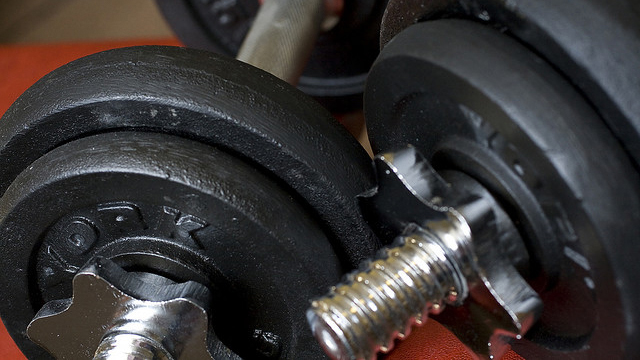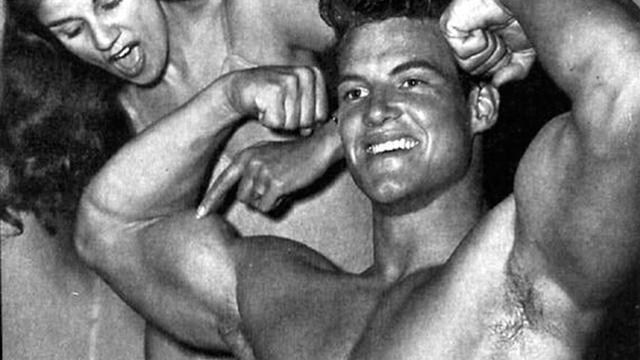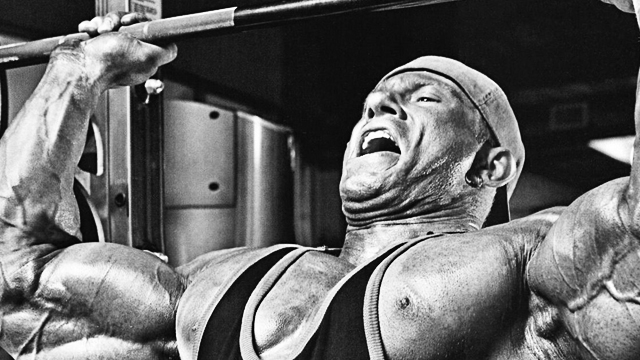It's been twelve days since you ditched all barbell pressing and withdrawal has been a bitch.
Your cuff rehab routine has been mind-numbing. You miss the strain of the big heavy iron, and good God, what about your shirts? Your pecs and shoulders can't start to shrink now, you just moved up to a size XL.
But you couldn't go on pressing in pain. Wisely, you abstained.
What if I told you there was a press that could change your life? A press that, for once, wouldn't get tagged as a destroyer, but as a healer. One that could add serious muscle in places that no other press could?
If you think you're dreaming, it's time to wake up, cause this exercise needs to be added to your program, regardless of shoulder health.
Barbell Woes
Complaints about pressing and shoulder pain run rampant and of all pressing implements, the barbell press causes the most problems. It alters the neutral alignment between the wrist, elbow, and shoulder.
There are people out there that bench press and overhead press without problems. I know, back in the old days everyone used to press with a barbell for overhead and bench work and they never had problems. Or so everyone tells me.
But you might not be in that category. Don't feel bad if you're not, and don't force yourself into it, either. Your anatomy is different. Your posture is different. Your history is different.
Whether you train yourself, clients, students, or athletes, don't write off pain. I'm sure if Tiger Woods was paying you millions of dollars to train him, you wouldn't make him do anything that would jeopardize his game.
So why subject Mr. Jones to it? Having to miss work because your trainer destroyed you last night isn't hard training, it's assault.
So what can we do if pressing is a no-go? Swiss bars and push-ups are common ways to press around shoulder problems, but not everyone has specialty bars, and loaded push-ups are a pain in the ass.
Enter the unilateral dumbbell floor press, the new/old solution to your pressing problems.


Why Unilateral?
Unilateral exercises are often deemed less effective than their bilateral counterparts because they can't be loaded as heavily. And since the load is offset, it requires more stabilization throughout the body. That means that sometimes, something other than the primary movers can hold you back. Those that have tried the unilateral dumbbell bench press know what I'm talking about.
Lifters often do their presses from a standing position for this very reason. They want to engage the entire kinetic chain to mimic how most movements are performed in both sports and real life.
This may be tagged as "functional" slop, but something tells me that firing the glutes and stabilizing the torso to produce movement at the shoulder isn't a bad thing.
For complicated reasons beyond torso strengthening, the unilateral version just works better. I have an overly scientific theory to explain why and it goes like this – you can't walk and chew bubble gum at the same time.
All available attention is allotted to one arm, which, for you math gurus, is 50% more than what there is in the bilateral version. It reminds us that we're doing more than exercising; we're accomplishing a specific goal.
Another advantage is the freedom to move and adjust your body position. If you lose your upper back tightness when taking the bar out of the rack during a bench press, there's no going back.
Dumbbells are easier to adjust, but when you use two you're going to be seesawing with weights above your face, making it look like you're scratching an unfortunate back itch. With only one shoulder pinned down, it's easier to get into proper position.
The Benefits – Expanded
What if you're the guy with perfectly healthy shoulders that's not lacking in upper chest development? Well, Mr. Franco Columbu, it's still a great exercise for your triceps and lockout strength, just like any floor press variation.
Dumbbell floor presses will help you lift more weight during pressing exercises, and more weight is usually a good thing.
So you have a choice. You could be the guy doing kickbacks to get your triceps jacked, or you could be the guy on the floor doing this exercise. Not only are your triceps going to thank you, but you're also doing your shoulders and upper chest a favor.
Healthy Shoulders
The unilateral floor press protects the shoulders because the lower half of the press is eliminated, and that's where funky stuff happens. Shoulders uncontrollably externally rotate themselves into the impingement zone. The slow and controlled descent becomes a ballistic bounce. Even though range of motion is sacrificed, it's better to eliminate the possibility of these things happening.
The true magic, however, happens in the lockout position. The dumbbell compresses the shoulder into its socket, seemingly reversing postural problems. When done correctly, the shoulder blade lies flat on the ground, and the entire body is locked down.
Another beauty is how the dumbbell subtly teeters back and forth. The shoulder stabilizes much like it would during more specific rotator cuff movements, like quadruped rhythmic stabilizations.
Your New Upper Chest
Guys can be insecure about a lot of things, but nothing takes its toll quite like a lackluster upper chest.
Sufferers try everything. Flies, cable crossovers, incline pressing. Often, none get the job done because, like other lacking body parts, there's no mental connection with the muscle. Most compound lifts put your body in a disadvantageous position for optimal activation, and that includes incline pressing. When you combine bad activation with sub-optimal biomechanics, you're not going to get a good contraction.
The unilateral floor press gasses the upper chest because it solves both problems. First, you have a free hand so you can palpate your upper chest during the lift. You don't hope it's contracting, you know it's contracting. This sensory connection increases activation.
Second, the biomechanics lends itself to greater upper chest activation. Dr. Clay Hyght, in Building a Bodybuilders Chest explains:
At least one study has shown that using a slightly narrower grip improves upper chest activation even more so than an incline bench angle. This is because using a slightly narrower grip forces the elbows to come slightly in towards the sides (adduction of the humerus) as opposed to them being flared.
Subsequently, this puts the clavicular pectoralis in a better mechanical advantage to do its primary function(s) – flexion and horizontal adduction.
Dr. Hyght was referring to a narrow grip on a barbell. Yet when using a barbell, no matter how narrow the grip, there's a propensity to flare the elbows because the hand is pronated, which shifts the workload to the lower chest.
With a dumbbell, however, it's easier to keep the elbows from flaring because your wrist is in a neutral position, so the upper chest does more work.
Setting Up
The most difficult part about the floor press is getting into position with the dumbbell at lockout without killing yourself. There are two ways to do this.
The first step is the rolling method. You don't need to be a Brazilian Jiu Jitsu champion to do this, so don't get discouraged. You just need a few principles so you don't twist your spine like a Twizzler.


Lie on your side and cuddle the dumbbell as close to your body as possible with your knees bent. This is going to reduce the lever arm, lowering the torque throughout your spine. Both hands are important, but the top hand is the one that grips the handle; the bottom hand supports.

Next, extend your top leg to the ground. The bottom leg stays tucked.
Begin the roll by looking over your top shoulder. Where the head goes the body follows, so the head always leads. Once you feel a pull in the dumbbell, use your hands to roll it onto your chest and abs. It should be able to rest comfortably here.
Extend both legs, and use both arms to press the dumbbell to a desired side.
Pics are great, but video is often better. Here's a video of the rolling setup and press:
Second is the heave-ho method, and more similar to what you're used to doing on a traditional bench. Spread your legs into a "V" with the dumbbell resting on the ground between them.
Tilt the dumbbell so that side closest to you rests on the ground, with the other side in the air.
Interlock your fingers around the handle. Rock your momentum forward, and explode backward, heaving the dumbbell to the lockout position.


And again, a video description:
Positioning: The How To
Regardless which method you use, you'll be at lockout with your feet extended. Squeeze your glutes and contract your abs to stabilize your body. This becomes more important as the weight increases.
Shift the dumbbell to the desired hand and make sure the shoulder is down and back. For you nerds out there – retract and depress the scapula. This is commonly known as a "packed" position.
However, remember that since you're only dealing with one dumbbell, you have more freedom to move. Wiggle around to set your shoulder if you have to; it's one of the perks this exercise offers.
Once you're confident that your shoulder is down and back, with the blade flat on the ground, either place your free hand on your chest, or let it roam in the air to challenge your stabilization even more. Hold this position for 5-10 seconds and just "feel" the head of the shoulder sink into its socket, while the upper back tightens. Now you're ready to go.
Form: The How To

After the isometric lockout hold, slide the elbow down next to your torso. When the upper arm hits the floor, pause for a second while keeping everything tight. It's like the box squat. Just because you come to a dead stop doesn't mean you take a nap.

After pausing, extend the arm to its original position by cueing yourself to push the shoulder blade into the ground. This helps to keep your shoulder packed. Your elbow stays tucked close to your torso; don't let it flare.
After completing your set, hold the dumbbell at lockout again for another 5-10 seconds. If you want more shoulder stability work, you can do what I call "the compass." After your set, at lockout, nudge the dumbbell north, south, east, and west to mimic quadruped rhythmic stabilizations. This can get dangerous with heavier weights, so save it for warm up sets.
Finishing: The How To
After finishing the set for one arm, return the dumbbell to the chest. Grip the dumbbell with the other hand, but use both to get to the lockout position.
Once both hands complete a set, return the dumbbell to the floor by reversing either setup.
If you're reversing the rolling directions, rest the dumbbell on your chest, tuck one leg to the side (the side you plan on rolling to), look over the shoulder, and cradle the dumbbell to the floor.
If you're reversing the heave-ho directions, hold the dumbbell at lockout with both hands, rock your momentum onto your thoracic spine, rock your momentum forward while doing a sit up, and place the dumbbell on the floor in between your legs.
Pressed to Action!
Add mass to your triceps, size up your upper chest, and increase your lockout strength, all while healing your shoulders? You bet!
Stop wallowing in your pressing woes and start doing something about it. Maybe you can't overhead press or bench press just yet, so take care of your problems and increase your strength at the same time. Regardless of your goals, the unilateral dumbbell floor press is worth your consideration.





